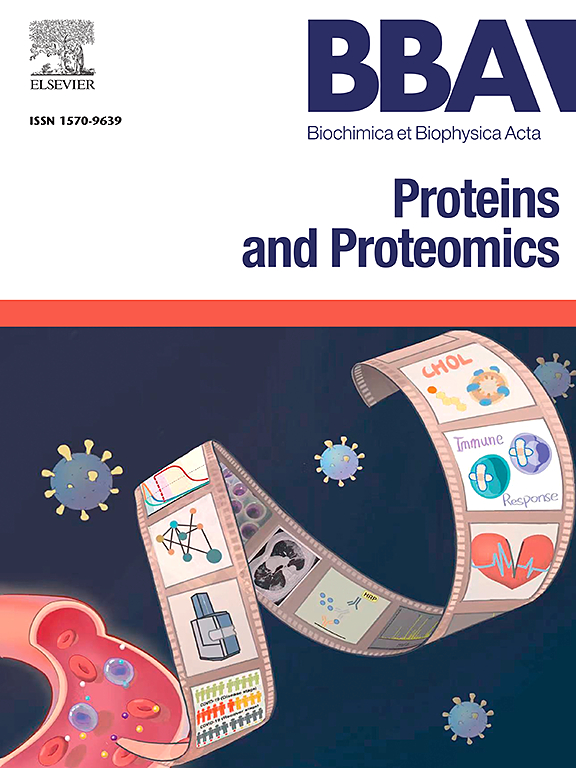Efficient production of a novel recombinant fusion protein of EIEC effector IpaD and EGFP: Biophysical characterization and functional studies
IF 2.3
4区 生物学
Q3 BIOCHEMISTRY & MOLECULAR BIOLOGY
Biochimica et biophysica acta. Proteins and proteomics
Pub Date : 2025-03-12
DOI:10.1016/j.bbapap.2025.141066
引用次数: 0
Abstract
The conserved invasion plasmid antigen D (IpaD) protein demonstrates broad protective capabilities against bacillary dysentery caused by Enteroinvasive Escherichia coli (EIEC) and Shigella. However, the instability of the IpaD protein at room temperature limits its therapeutic potential. The stabilization and efficient production of functional recombinant proteins remain critical challenges in therapeutic and vaccine development. This study presents a novel fluorescence fusion strategy for producing a stable IpaD-EGFP recombinant protein using a flexible linker (GGGGS)₃. The fusion technique enhances the expression level (∼53 %), solubility (∼77 %), and stability of the IpaD-EGFP fusion protein. Biophysical characterization studies suggest that the IpaD-EGFP fusion protein is stable at refrigerated temperatures for extended periods and up to 1 month at 25 °C. The IpaD-EGFP protein triggers apoptosis in Raw 267.4 cells through activation of caspases 3/7. The protein also induces antibody response in BALB/c mice indicating its immunogenicity. Together, these findings indicate that IpaD-EGFP generated in this study is a potential approach for the design and production of stable IpaD-based protein therapeutics, breaking the expensive “cold chain” of continuous refrigeration. Fusion approach significantly enhanced the solubility, yield, and stability of IpaD, while enabling efficient purification.
一种新的EIEC效应物IpaD和EGFP重组融合蛋白的高效生产:生物物理特性和功能研究。
保守的侵袭质粒抗原D (IpaD)蛋白对肠侵袭性大肠杆菌(EIEC)和志贺氏菌(Shigella)引起的细菌性痢疾具有广泛的保护作用。然而,IpaD蛋白在室温下的不稳定性限制了它的治疗潜力。功能性重组蛋白的稳定和高效生产仍然是治疗和疫苗开发中的关键挑战。该研究提出了一种新的荧光融合策略,用于使用柔性连接体(GGGGS)₃产生稳定的IpaD-EGFP重组蛋白。融合技术提高了IpaD-EGFP融合蛋白的表达水平(~53 %)、溶解度(~77 %)和稳定性。生物物理特性研究表明,IpaD-EGFP融合蛋白在25 °C的冷藏温度下长时间稳定,可达1 个月。IpaD-EGFP蛋白通过激活caspases 3/7触发Raw 267.4细胞凋亡。该蛋白还在BALB/c小鼠中诱导抗体反应,表明其免疫原性。总之,这些发现表明,本研究中产生的IpaD-EGFP是设计和生产稳定的基于ipad的蛋白质疗法的潜在方法,打破了昂贵的连续冷藏“冷链”。融合方法显著提高了IpaD的溶解度、产率和稳定性,同时实现了高效的纯化。
本文章由计算机程序翻译,如有差异,请以英文原文为准。
求助全文
约1分钟内获得全文
求助全文
来源期刊
CiteScore
8.00
自引率
0.00%
发文量
55
审稿时长
33 days
期刊介绍:
BBA Proteins and Proteomics covers protein structure conformation and dynamics; protein folding; protein-ligand interactions; enzyme mechanisms, models and kinetics; protein physical properties and spectroscopy; and proteomics and bioinformatics analyses of protein structure, protein function, or protein regulation.

 求助内容:
求助内容: 应助结果提醒方式:
应助结果提醒方式:


